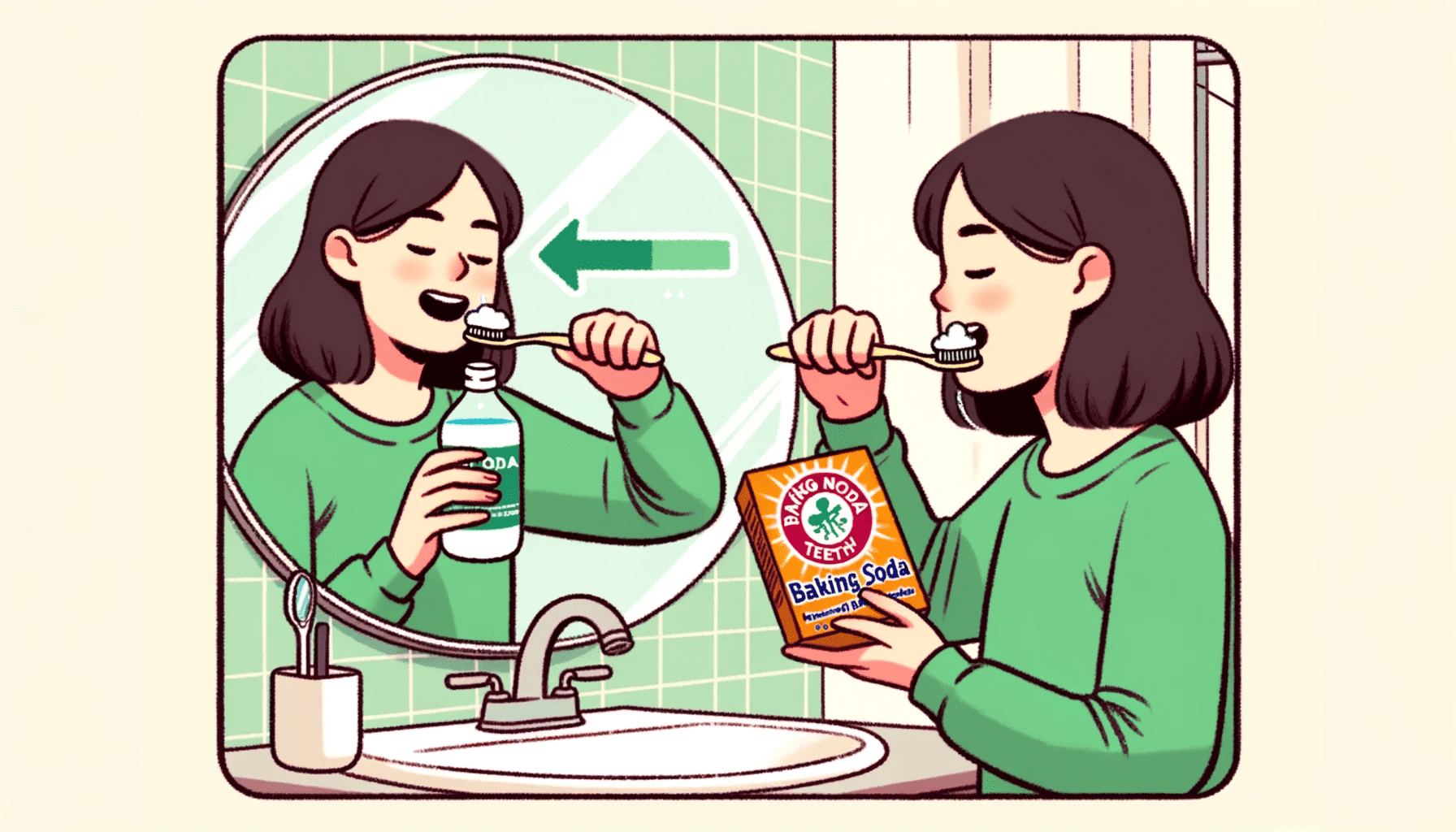Baking Soda for Whitening Teeth: A Comprehensive Guide to Safety and Effectiveness
Baking soda, a common household item, has made its way into many oral care conversations. But does it really have the power to whiten teeth? The idea of using baking soda for whitening teeth has been around for a while, and many swear by its effectiveness.
This mild abrasive has been touted as a natural teeth whitener, but how does it compare to commercial teeth whitening products? And more importantly, is it safe for regular use? In this article, we’ll delve into the science behind baking soda’s potential tooth-whitening properties, weigh its pros and cons, and provide insights from dental professionals. Whether you’re considering a DIY approach to teeth whitening or just curious about the buzz, we’ve got the answers you’re looking for.
What is Baking Soda?
Baking soda, also known as sodium bicarbonate, is a white crystalline powder that is commonly used as a leavening agent in baking. But its uses extend far beyond the kitchen. This versatile substance is a mild abrasive, which means it has the ability to scrub away surface stains on various materials, including your teeth.
Baking soda is alkaline and can neutralize acids, making it a popular choice for cleaning and deodorizing. In the context of dental care, it’s often included as an ingredient in toothpaste formulations. But what makes it a subject of interest is its purported ability to whiten teeth. Before you swap out your regular toothpaste for a box of baking soda, it’s essential to understand how it works and whether it’s a safe and effective teeth whitener.
Does Baking Soda Whiten Teeth?
Yes, baking soda can whiten teeth to some extent. According to a study published in The Journal of the American Dental Association, toothpaste containing baking soda showed better whitening results compared to those without1. However, it’s crucial to understand the mechanism behind its whitening effect.
Baking soda is a mild abrasive, which means it can scrub away surface stains on the enamel of your teeth. When you brush your teeth with baking soda, the particles in the powder break down to remove stains more effectively than non-abrasive toothpaste. Additionally, its alkaline nature helps balance the pH levels in your mouth, creating an environment where bacteria struggle to thrive. While it may not offer the dramatic results of professional whitening treatments, it can make a noticeable difference when used correctly and consistently.
Is it Safe to Whiten Teeth with Baking Soda?
Yes, it is generally safe to use baking soda for teeth whitening, but there are some caveats to consider. The American Dental Association has noted that baking soda is a safe, low-abrasive ingredient found in many ADA-approved toothpastes. However, using baking soda alone may not provide you with fluoride, which protects teeth from cavities.
Baking soda is a mild abrasive, so excessive use can damage your tooth enamel and potentially lead to tooth sensitivity. It’s essential to use a toothpaste that contains baking soda rather than applying baking soda alone on your teeth.
Moreover, baking soda doesn’t kill bacteria, which means it won’t replace the full spectrum of benefits you get from regular toothpaste containing fluoride and other antibacterial agents. If you have sensitive teeth or existing dental work like crowns or fillings, consult your dentist before using baking soda as a teeth whitener.
Does Baking Soda Get Rid of Yellow Teeth?
Yes, baking soda can help in reducing the appearance of yellow teeth to some extent. The abrasive nature of baking soda works on the surface stains that often cause teeth to appear yellow. It’s particularly effective against stains caused by coffee, tea, and smoking. However, it’s important to note that baking soda works primarily on surface stains and may not be effective for deeper, intrinsic stains that are usually addressed by professional whitening treatments.
When you use baking soda to brush your teeth, the fine particles in the baking soda act as a gentle abrasive to scrub away the surface stains on your teeth. However, for significant discoloration or for stains that are deep within the tooth, more potent treatments like hydrogen peroxide or professional whitening may be necessary. Always consult your dentist for personalized advice, especially if you have sensitive teeth or other oral health conditions.
How Often Should I Brush My Teeth with Baking Soda?
From my experience as a dental professional, I usually advise my patients to be cautious when using baking soda directly on their teeth. While baking soda can be effective in removing surface stains, it’s essential to strike a balance to ensure the safety of your tooth enamel.
For those looking to incorporate baking soda into their oral hygiene routine, I recommend using it no more than once or twice a week. This frequency allows you to benefit from its whitening properties without overexposing your teeth to its abrasive nature. Remember, while baking soda can help with surface stains, it doesn’t offer the protective benefits of fluoride toothpaste. So, it’s crucial to continue using your regular toothpaste daily.
If you’re considering using baking soda for an extended period, or if you have specific dental concerns, it’s always a good idea to consult with your dentist. They can provide personalized advice tailored to your oral health needs.
Also Read: Does Coconut Oil Whiten Teeth? A Dentist’s Analysis
How to Whiten Your Teeth With Baking Soda? A Dentist’s Stepwise Guide
Whitening your teeth with baking soda is a simple process, but it’s crucial to do it correctly to ensure you’re not harming your enamel or gums. Here’s a step-by-step guide based on what I usually recommend to my patients:
Step 1: Gather Your Supplies
- Baking soda
- A small cup or bowl
- Toothbrush
- Regular fluoride toothpaste
- Water
Step 2: Prepare the Baking Soda Paste
In a small cup or bowl, mix a few teaspoons of baking soda with a small amount of water to create a paste. The texture of baking soda makes it a mild abrasive, which is what helps remove surface stains from your teeth.
Step 3: Apply the Paste to Your Toothbrush
Dip your toothbrush into the baking soda paste. Make sure to coat the bristles evenly. You can also add a layer of your regular toothpaste if you wish.
Step 4: Brush with Baking Soda
Gently brush your teeth using circular motions. Focus on the teeth that are most visibly stained. Do not brush for more than two minutes.
Step 5: Rinse Thoroughly
After brushing, spit out the baking soda and rinse your mouth with water or mouthwash. Make sure to rinse your toothbrush as well.
Step 6: Follow Up with Regular Toothpaste
For added protection, I recommend following up with a regular fluoride toothpaste. This will help protect your teeth from cavities and provide the fluoride needed for healthy teeth.
Step 7: Observe and Repeat
If you’re satisfied with the results, continue this routine no more than once or twice a week. If you experience any sensitivity or discomfort, stop using baking soda immediately and consult your dentist.
Remember, while baking soda can be effective for removing surface stains, it’s not a substitute for professional dental care. Always consult your dentist before starting any new oral health routine.
Baking Soda or Hydrogen Peroxide? Which One Should You Choose and Why?
When it comes to at-home teeth whitening, two common ingredients often come up: baking soda and hydrogen peroxide. Both have their merits, but they work in different ways and come with their own sets of precautions. Here’s a breakdown to help you decide which one might be better suited for your needs.
Baking Soda: The Mild Abrasive
Baking soda is a mild abrasive that can remove surface stains on your teeth, making them appear whiter. It’s also alkaline, which helps balance the pH levels in your mouth, potentially reducing bad breath and neutralizing acid from foods and drinks.
Pros:
- Easily accessible and affordable
- Mild abrasive properties help remove surface stains
- Alkaline nature can help balance oral pH
Cons:
- Not effective for deep stains or discoloration
- Can be abrasive if used too frequently, potentially damaging enamel
- Doesn’t offer antibacterial properties
Hydrogen Peroxide: The Chemical Whitener
Hydrogen peroxide is a bleaching agent that penetrates the tooth enamel to remove deep stains. It’s often found in professional whitening treatments and some over-the-counter teeth whitening products.
Pros:
- Effective for deeper stains
- Offers antibacterial benefits, which can help with oral health
- Often used in professional whitening treatments
Cons:
- Can cause tooth sensitivity
- Not recommended for long-term use without dentist supervision
- May irritate gums or other soft tissues in the mouth
The Verdict
If you’re looking for a quick, affordable way to tackle surface stains, baking soda could be your go-to. However, for deeper stains or a more dramatic whitening effect, hydrogen peroxide is generally more effective.
In any case, it’s always best to consult your dentist before starting any new teeth-whitening regimen. They can provide personalized advice based on your oral health conditions and the results you’re looking to achieve.


